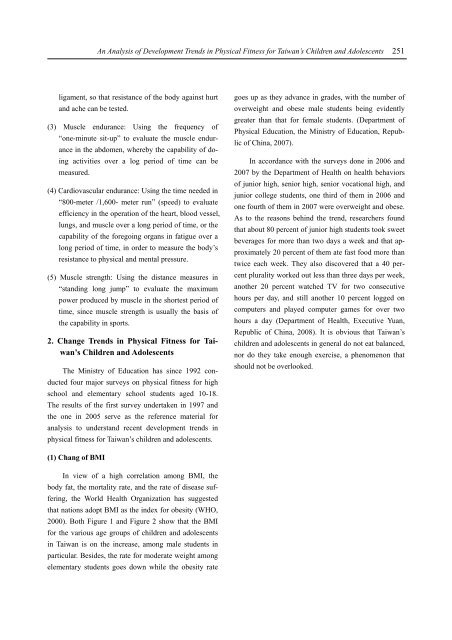PDF(2.7mb) - 國家政策研究基金會
PDF(2.7mb) - 國家政策研究基金會
PDF(2.7mb) - 國家政策研究基金會
You also want an ePaper? Increase the reach of your titles
YUMPU automatically turns print PDFs into web optimized ePapers that Google loves.
An Analysis of Development Trends in Physical Fitness for Taiwan’s Children and Adolescents 251<br />
ligament, so that resistance of the body against hurt<br />
and ache can be tested.<br />
(3) Muscle endurance: Using the frequency of<br />
“one-minute sit-up” to evaluate the muscle endurance<br />
in the abdomen, whereby the capability of doing<br />
activities over a log period of time can be<br />
measured.<br />
(4) Cardiovascular endurance: Using the time needed in<br />
“800-meter /1,600- meter run” (speed) to evaluate<br />
efficiency in the operation of the heart, blood vessel,<br />
lungs, and muscle over a long period of time, or the<br />
capability of the foregoing organs in fatigue over a<br />
long period of time, in order to measure the body’s<br />
resistance to physical and mental pressure.<br />
(5) Muscle strength: Using the distance measures in<br />
“standing long jump” to evaluate the maximum<br />
power produced by muscle in the shortest period of<br />
time, since muscle strength is usually the basis of<br />
the capability in sports.<br />
2. Change Trends in Physical Fitness for Taiwan’s<br />
Children and Adolescents<br />
The Ministry of Education has since 1992 conducted<br />
four major surveys on physical fitness for high<br />
school and elementary school students aged 10-18.<br />
The results of the first survey undertaken in 1997 and<br />
the one in 2005 serve as the reference material for<br />
analysis to understand recent development trends in<br />
physical fitness for Taiwan’s children and adolescents.<br />
goes up as they advance in grades, with the number of<br />
overweight and obese male students being evidently<br />
greater than that for female students. (Department of<br />
Physical Education, the Ministry of Education, Republic<br />
of China, 2007).<br />
In accordance with the surveys done in 2006 and<br />
2007 by the Department of Health on health behaviors<br />
of junior high, senior high, senior vocational high, and<br />
junior college students, one third of them in 2006 and<br />
one fourth of them in 2007 were overweight and obese.<br />
As to the reasons behind the trend, researchers found<br />
that about 80 percent of junior high students took sweet<br />
beverages for more than two days a week and that approximately<br />
20 percent of them ate fast food more than<br />
twice each week. They also discovered that a 40 percent<br />
plurality worked out less than three days per week,<br />
another 20 percent watched TV for two consecutive<br />
hours per day, and still another 10 percent logged on<br />
computers and played computer games for over two<br />
hours a day (Department of Health, Executive Yuan,<br />
Republic of China, 2008). It is obvious that Taiwan’s<br />
children and adolescents in general do not eat balanced,<br />
nor do they take enough exercise, a phenomenon that<br />
should not be overlooked.<br />
(1) Chang of BMI<br />
In view of a high correlation among BMI, the<br />
body fat, the mortality rate, and the rate of disease suffering,<br />
the World Health Organization has suggested<br />
that nations adopt BMI as the index for obesity (WHO,<br />
2000). Both Figure 1 and Figure 2 show that the BMI<br />
for the various age groups of children and adolescents<br />
in Taiwan is on the increase, among male students in<br />
particular. Besides, the rate for moderate weight among<br />
elementary students goes down while the obesity rate

















